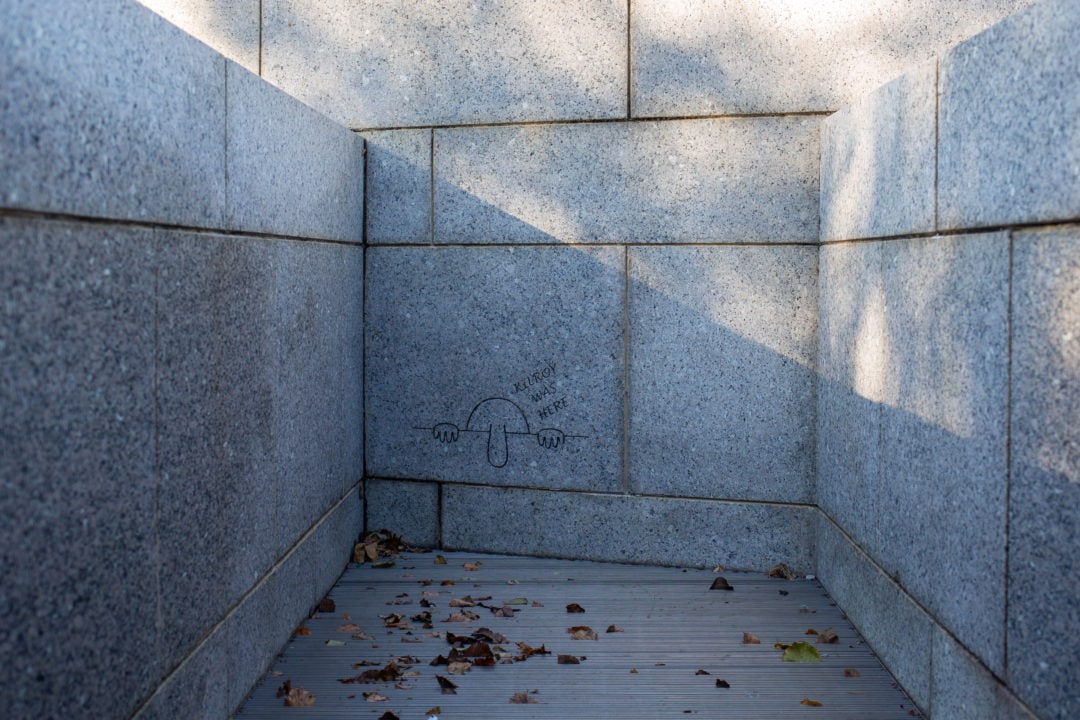“In war, there are no unwounded soldiers.” Those words are etched onto a translucent glass panel at the American Veterans Disabled for Life Memorial, just one of many public spaces in Washington, D.C., and around the country dedicated to former members of the U.S. Armed Forces.
The District in particular, with its larger-than-life marble monuments, high-profile funeral rituals, and candlelight vigils, can sometimes feel as if its residents and visitors are always mourning one thing or another. But although they are built to honor the wounded or dead, memorials serve to highlight the bravery of ordinary people under extraordinary circumstances.
Take This Trip to Veteran Memorials Around the U.S.
According to the U.S. Department of Defense, “Veterans Day honors all of those who have served the country in war or peace—dead or alive—although it’s largely intended to thank living veterans for their sacrifices.” Dedicated on October 5, 2014, the American Veterans Disabled for Life Memorial is the most recent of several memorials located on or near the National Mall to honor those who served. The first national memorial dedicated exclusively to disabled veterans comprises 48 glass panels, a star-shaped fountain and reflecting pool, granite walls, a tree grove, and large bronze sculptures.
Further west, the World War II Memorial honors the service of 16 million members of the Armed Forces, the support of women and others on the home front, and the deaths of 405,399 Americans. A sign posted by the National Park Service encourages visitors to sit with their feet in the water of the memorial’s Rainbow Pool, in deference to the troops who celebrated the end of the war in part by dancing in fountains around Europe. A wall of more than 4,000 gold stars—each representing 100 Americans who died in the war or remain missing—is a sobering reminder that, as Colonel Oveta Culp Hobby, the first director of the Women’s Army Corps said, “This was a people’s war, and everyone was in it.”
But perhaps nothing is as effective at illustrating the immense cost of war as the Vietnam Veterans Memorial. Featuring a black granite wall etched with the names of 58,318 Americans who died or went missing in action from 1959 until May 15, 1975, the shiny surface physically reflects back images of visitors and their lively surroundings. The simplicity of the design and stark visuals encourage internal reflection as well.
At the American Veterans Disabled for Life Memorial, a quote from Dr. Hampar Kelikian, a surgeon and pioneer in the restoration of damaged limbs, urges visitors to “start by not thinking so much anymore about what you have lost. You must think about what you have left … and what you can do with it.”

One of the 48 glass panels etched with photographs and quotes at the American Veterans Disabled for Life Memorial.

The World War II Memorial features a ring of granite columns each representing a U.S. state or territory. The memorial sits on the National Mall with views of the Washington Monument, the Lincoln Memorial, and the Capitol.

Four bronze sculptures by Larry Kirkland at the American Veterans Disabled for Life Memorial use negative space and silhouettes to highlight some of the challenges faced by disabled veterans.

A wall of gold stars at the World War II Memorial, each representing 100 lives lost, highlights the high price of freedom.

Visitors are encouraged to stick their feet into the water at the World War II Memorial, reminiscent of the ways members of the Armed Forces celebrated the end of the war in Europe.

Located near the Lincoln Memorial, the Korean War Veterans Memorial was dedicated in 1995 and features a Wall of Remembrance and 19 stainless steel statues depicting soldiers in combat.

In a nod to a graffiti subject popular with GIs in the 1940s, a “Kilroy was here” doodle was etched in a somewhat-hidden nook of the World War II Memorial.

The shiny surface of the Vietnam Veterans Memorial wall is etched with names of the dead and missing but reflects back scenes of life from the National Mall.

The names on the Vietnam Veterans Memorial wall are listed chronologically, beginning in 1959 and ending in 1975, at the center and highest point of the wall so the first and last deaths meet in the middle.

Visitors to the Vietnam Veterans Memorial can look up names in directories located near the wall and leave trinkets, flowers, and flags to commemorate those lost in the 16-year-long war.

The Vietnam Veterans Memorial, designed by 21-year-old architecture student Maya Lin, was dedicated on November 11, 1982. A reading of each engraved name at the Washington National Cathedral took 56 hours to complete.






